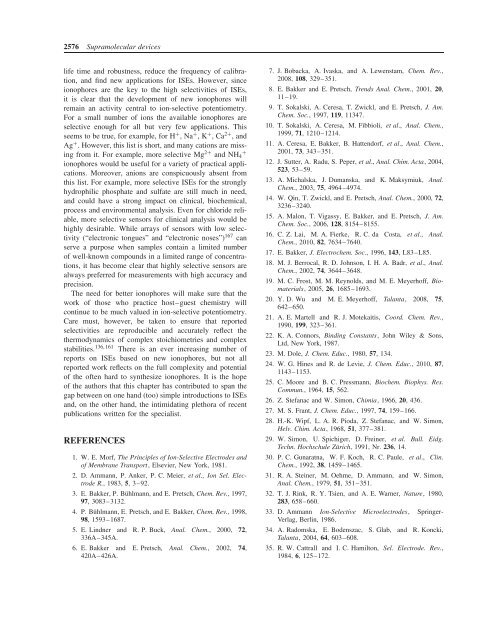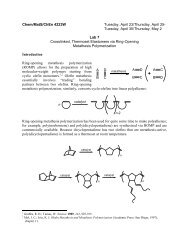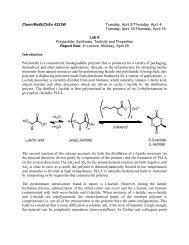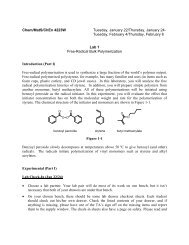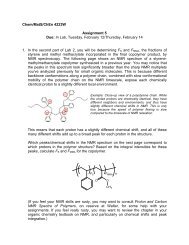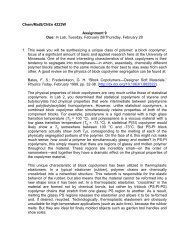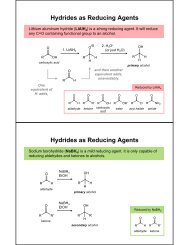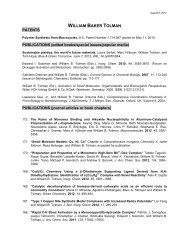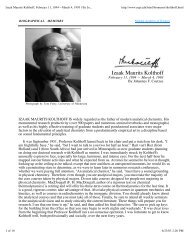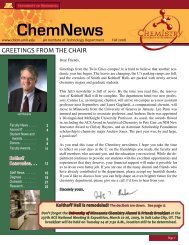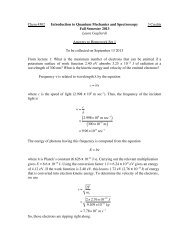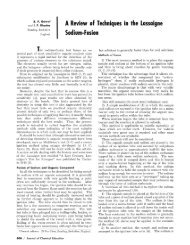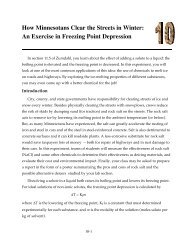Ion-Selective Electrodes With Ionophore-Doped Sensing Membranes
Ion-Selective Electrodes With Ionophore-Doped Sensing Membranes
Ion-Selective Electrodes With Ionophore-Doped Sensing Membranes
Create successful ePaper yourself
Turn your PDF publications into a flip-book with our unique Google optimized e-Paper software.
2576 Supramolecular devices<br />
life time and robustness, reduce the frequency of calibration,<br />
and find new applications for ISEs. However, since<br />
ionophores are the key to the high selectivities of ISEs,<br />
it is clear that the development of new ionophores will<br />
remain an activity central to ion-selective potentiometry.<br />
For a small number of ions the available ionophores are<br />
selective enough for all but very few applications. This<br />
seems to be true, for example, for H + ,Na + ,K + ,Ca 2+ ,and<br />
Ag + . However, this list is short, and many cations are missing<br />
from it. For example, more selective Mg 2+ +<br />
and NH 4<br />
ionophores would be useful for a variety of practical applications.<br />
Moreover, anions are conspicuously absent from<br />
this list. For example, more selective ISEs for the strongly<br />
hydrophilic phosphate and sulfate are still much in need,<br />
and could have a strong impact on clinical, biochemical,<br />
process and environmental analysis. Even for chloride reliable,<br />
more selective sensors for clinical analysis would be<br />
highly desirable. While arrays of sensors with low selectivity<br />
(“electronic tongues” and “electronic noses”) 167 can<br />
serve a purpose when samples contain a limited number<br />
of well-known compounds in a limited range of concentrations,<br />
it has become clear that highly selective sensors are<br />
always preferred for measurements with high accuracy and<br />
precision.<br />
The need for better ionophores will make sure that the<br />
work of those who practice host–guest chemistry will<br />
continue to be much valued in ion-selective potentiometry.<br />
Care must, however, be taken to ensure that reported<br />
selectivities are reproducible and accurately reflect the<br />
thermodynamics of complex stoichiometries and complex<br />
136, 161<br />
stabilities. There is an ever increasing number of<br />
reports on ISEs based on new ionophores, but not all<br />
reported work reflects on the full complexity and potential<br />
of the often hard to synthesize ionophores. It is the hope<br />
of the authors that this chapter has contributed to span the<br />
gap between on one hand (too) simple introductions to ISEs<br />
and, on the other hand, the intimidating plethora of recent<br />
publications written for the specialist.<br />
REFERENCES<br />
1. W. E. Morf, The Principles of <strong>Ion</strong>-<strong>Selective</strong> <strong>Electrodes</strong> and<br />
of Membrane Transport, Elsevier, New York, 1981.<br />
2. D. Ammann, P. Anker, P. C. Meier, et al., <strong>Ion</strong> Sel. Electrode<br />
R., 1983, 5, 3–92.<br />
3. E. Bakker, P. Bühlmann, and E. Pretsch, Chem. Rev., 1997,<br />
97, 3083–3132.<br />
4. P. Bühlmann, E. Pretsch, and E. Bakker, Chem. Rev., 1998,<br />
98, 1593–1687.<br />
5. E. Lindner and R. P. Buck, Anal. Chem., 2000, 72,<br />
336A–345A.<br />
6. E. Bakker and E. Pretsch, Anal. Chem., 2002, 74,<br />
420A–426A.<br />
7. J. Bobacka, A. Ivaska, and A. Lewenstam, Chem. Rev.,<br />
2008, 108, 329–351.<br />
8. E. Bakker and E. Pretsch, Trends Anal. Chem., 2001, 20,<br />
11–19.<br />
9. T. Sokalski, A. Ceresa, T. Zwickl, and E. Pretsch, J. Am.<br />
Chem. Soc., 1997, 119, 11347.<br />
10. T. Sokalski, A. Ceresa, M. Fibbioli, et al., Anal. Chem.,<br />
1999, 71, 1210–1214.<br />
11. A. Ceresa, E. Bakker, B. Hattendorf, et al., Anal. Chem.,<br />
2001, 73, 343–351.<br />
12. J. Sutter, A. Radu, S. Peper, et al., Anal. Chim. Acta, 2004,<br />
523, 53–59.<br />
13. A. Michalska, J. Dumanska, and K. Maksymiuk, Anal.<br />
Chem., 2003, 75, 4964–4974.<br />
14. W. Qin, T. Zwickl, and E. Pretsch, Anal. Chem., 2000, 72,<br />
3236–3240.<br />
15. A. Malon, T. Vigassy, E. Bakker, and E. Pretsch, J. Am.<br />
Chem. Soc., 2006, 128, 8154–8155.<br />
16. C. Z. Lai, M. A. Fierke, R. C. da Costa, et al., Anal.<br />
Chem., 2010, 82, 7634–7640.<br />
17. E. Bakker, J. Electrochem. Soc., 1996, 143, L83–L85.<br />
18. M. J. Berrocal, R. D. Johnson, I. H. A. Badr, et al., Anal.<br />
Chem., 2002, 74, 3644–3648.<br />
19. M. C. Frost, M. M. Reynolds, and M. E. Meyerhoff, Biomaterials,<br />
2005, 26, 1685–1693.<br />
20. Y. D. Wu and M. E. Meyerhoff, Talanta, 2008, 75,<br />
642–650.<br />
21. A. E. Martell and R. J. Motekaitis, Coord. Chem. Rev.,<br />
1990, 199, 323–361.<br />
22. K. A. Connors, Binding Constants, John Wiley & Sons,<br />
Ltd, New York, 1987.<br />
23. M. Dole, J. Chem. Educ., 1980, 57, 134.<br />
24. W. G. Hines and R. de Levie, J. Chem. Educ., 2010, 87,<br />
1143–1153.<br />
25. C. Moore and B. C. Pressmann, Biochem. Biophys. Res.<br />
Commun., 1964, 15, 562.<br />
26. Z. Stefanac and W. Simon, Chimia, 1966, 20, 436.<br />
27. M. S. Frant, J. Chem. Educ., 1997, 74, 159–166.<br />
28. H.-K. Wipf, L. A. R. Pioda, Z. Stefanac, and W. Simon,<br />
Helv. Chim. Acta, 1968, 51, 377–381.<br />
29. W. Simon, U. Spichiger, D. Freiner, et al. Bull. Eidg.<br />
Techn. Hochschule Zürich, 1991, Nr. 236, 14.<br />
30. P. C. Gunaratna, W. F. Koch, R. C. Paule, et al., Clin.<br />
Chem., 1992, 38, 1459–1465.<br />
31. R. A. Steiner, M. Oehme, D. Ammann, and W. Simon,<br />
Anal. Chem., 1979, 51, 351–351.<br />
32. T. J. Rink, R. Y. Tsien, and A. E. Warner, Nature, 1980,<br />
283, 658–660.<br />
33. D. Ammann <strong>Ion</strong>-<strong>Selective</strong> Microelectrodes, Springer-<br />
Verlag, Berlin, 1986.<br />
34. A. Radomska, E. Bodenszac, S. Glab, and R. Koncki,<br />
Talanta, 2004, 64, 603–608.<br />
35. R. W. Cattrall and I. C. Hamilton, Sel. Electrode. Rev.,<br />
1984, 6, 125–172.


